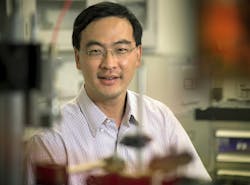Conventional high-power lasers are bulky and require equipment that makes them difficult to use in portable platforms, but a University of Texas at Arlington engineer is working to develop a semiconductor laser that addresses these issues. Weidong Zhou, a professor in the Electrical Engineering Department, is the primary investigator in a 5-year, $3 million Multidisciplinary Research Initiatives grant from the High Energy Laser Joint Technology Office to develop a high-power semiconductor laser that is compact, efficient, and power-scalable.
RELATED ARTICLE: Terahertz spectroscopy and imaging of 3D semiconductors breaks the nanometer barrier
Zhou is collaborating with Ganesh Balakrishnan of the University of New Mexico, Shanhui Fan of Stanford University, and the Air Force Research Laboratory.
Semiconductor lasers use a cavity to create feedback that bounces light back and forth, eventually sending the light from the face of the laser. The laser has become an important tool in forging the next generation of innovative technologies, with anticipated revenue of more than $10 billion in 2016.
However, challenges remain in scaling laser power toward kilo- and megawatt levels, while maintaining excellent beam quality, high-energy efficiency, and compact size. Zhou and the team will rely on nanotechnology principles and structures toward power-scalable, high-power lasers.
"We have been looking at various aspects of lasers in areas where higher-power infrared lasers would be highly desirable--the military, manufacturing and security, for example--and how to address the major challenges associated with those applications," Zhou said. "If we are successful in creating a semiconductor laser based on nanotechnologies, we can greatly reduce the size of these lasers while increasing their power and efficiency."
The laser could eventually be built on a semiconductor wafer. Control electronics and packaging necessary to operate the laser could increase its size to that of a computer, considerably smaller than current laser operation packages.
Some promising applications for these lasers would be precision laser-cutting and 3D machining that could be performed on a tabletop machine instead of a machine that takes up much of a room and lidar sensing for autonomous vehicles. Smaller platforms also would be much more cost-effective.
Zhou is a Fellow of the International Society for Optical Engineering. He has more than 300 journal publications and conference presentations. He joined UTA in 2004 after a brief career in industry. He has been the primary investigator on research grants totaling nearly $8 million and has been involved with more than 40 projects totaling more than $20 million since 2004.
The Electrical Engineering Department is an integral component of UTA's College of Engineering, which is the third-largest in Texas with an enrollment of more than 7200.
Peter Crouch, dean of the College of Engineering, commended Zhou’s innovations as a model of the University's work to advance Global Environmental Impact under the Strategic Plan 2020: Bold Solutions - Global Impact.
SOURCE: University of Texas at Arlington; http://www.uta.edu/news/releases/2017/06/zhou-little-lasers.php

